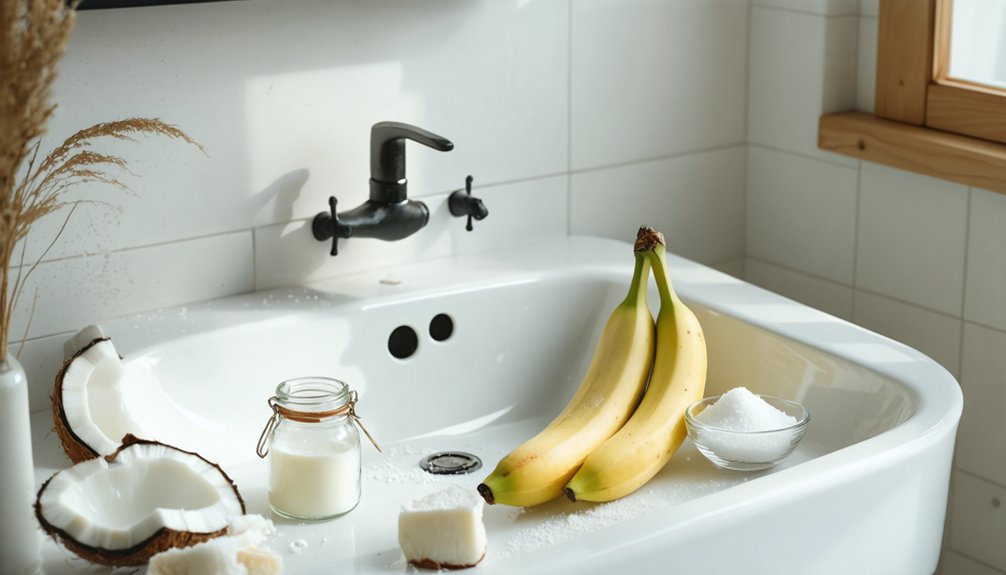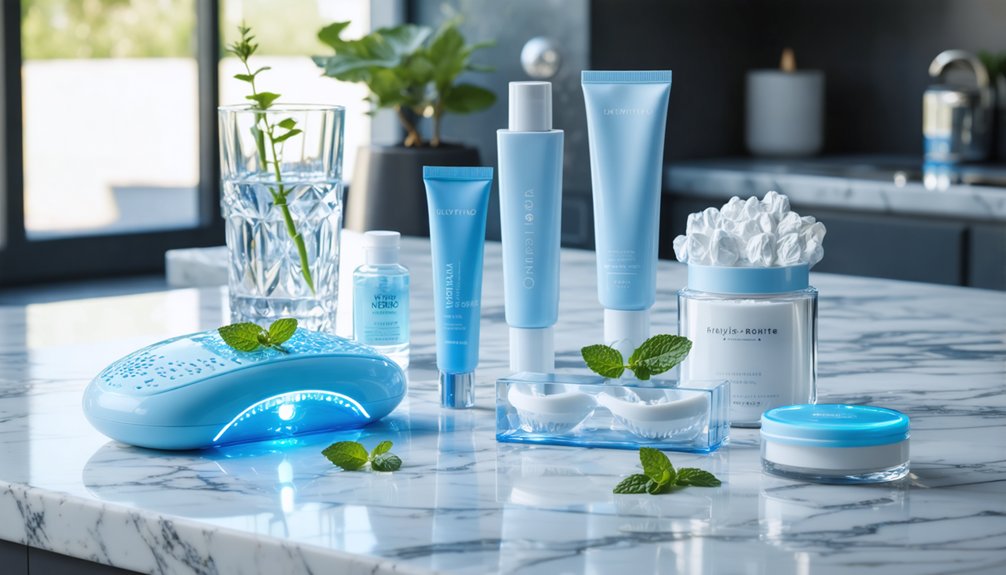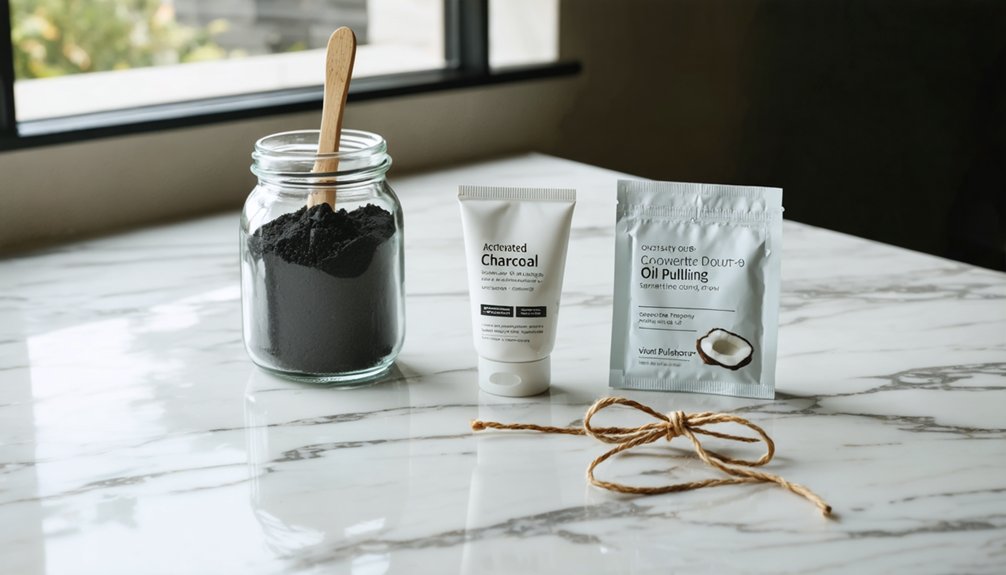You’ll find effective relief with sensitivity-focused whitening toothpastes containing potassium nitrate and fluoride, like Sensodyne Pronamel or Colgate Sensitive Maximum Strength. For gradual results, apply whitening strips with lower peroxide concentrations (3-10%) and use desensitizing gel beforehand. Natural alternatives include baking soda paste or coconut oil pulling. Proper timing between treatments and preventive measures can help you achieve a brighter smile while maintaining comfort.
Key Takeaways
- Use ADA-approved whitening toothpaste with potassium nitrate and fluoride, like Sensodyne Pronamel or Colgate Sensitive Maximum Strength.
- Mix baking soda with water to create a gentle, natural whitening paste that’s safe for sensitive teeth.
- Choose whitening strips with lower peroxide concentrations (3-10%) and apply desensitizing gel beforehand to minimize discomfort.
- Practice oil pulling with coconut oil as a chemical-free alternative for gradual teeth whitening.
- Maintain results by using soft-bristled toothbrushes and incorporating calcium-rich foods into your diet for stronger enamel.
Understanding Sensitive Teeth and Their Whitening Needs
When considering teeth whitening options, understanding the mechanisms behind tooth sensitivity is essential for achieving ideal results safely.
Your tooth sensitivity occurs when worn enamel exposes dentin tubules connected to nerve endings, triggering pain from temperature changes and sweet substances. Common sensitivity causes include receding gums, decay, grinding, and harsh toothpaste use.
Exposed dentin tubules from damaged enamel create tooth sensitivity, making your teeth react painfully to hot, cold and sugary stimuli.
Whitening agents, particularly peroxides, can penetrate your enamel and irritate nerve endings, potentially intensifying existing sensitivity. Many over-the-counter whitening products contain high peroxide levels that can worsen tooth discomfort.
That’s why proper enamel protection during whitening becomes vital for your comfort and results. Before starting any whitening treatment, you’ll need an assessment of pre-existing dental issues to prevent complications. Underlying issues like periodontal disease must be addressed before proceeding with any whitening regimen.
Gentle Whitening Toothpastes for Daily Care
When choosing a whitening toothpaste for sensitive teeth, you’ll want to prioritize formulas containing proven protective ingredients like potassium nitrate and fluoride.
You can achieve noticeable results through daily brushing with gentle, low-abrasive options such as Sensodyne Pronamel or Colgate Sensitive Maximum Strength, which won’t compromise your enamel health. For optimal results, apply a 1-inch strip of toothpaste and brush thoroughly twice daily.
These scientifically-backed formulations offer gradual whitening while maintaining the essential barrier function of your tooth enamel, making them a smart long-term investment in your oral health. If sensitivity persists beyond 4 weeks of use, it’s important to schedule a dental appointment to rule out serious underlying issues.
Safe Ingredients Matter Most
For patients seeking gentler teeth whitening solutions, the key ingredients in daily whitening toothpastes considerably impact both safety and efficacy.
You’ll find that budget options containing 5% potassium nitrate effectively reduce tooth sensitivity by blocking nerve pain signals.
When evaluating ingredient safety, look for formulas with sodium fluoride (1,150-1,450 ppm) and hydrated silica, which provide gentle stain removal without excessive enamel wear.
Avoid whitening products containing hydrogen peroxide or carbamide peroxide, as these can increase sensitivity. The ADA seal of approval on whitening toothpaste ensures both safety and effectiveness for regular use.
Instead, choose toothpastes that rely on mild abrasives for surface stain removal. Products like Sensodyne provide long-lasting sensitivity relief with consistent twice-daily use.
The most effective budget-friendly formulations will include sorbitol and glycerin as stabilizing agents, while maintaining the gentle action needed for daily use in sensitive teeth care.
Consistent Brushing Shows Results
The effectiveness of gentle whitening toothpastes hinges on consistent daily application with proper technique. You’ll achieve ideal results by brushing twice daily for two minutes using a soft-bristled toothbrush and appropriate pressure.
With regular use, expect to see gradual results of 1-2 shades lighter within 2-4 weeks. Common ingredients like hydrated silica and mild abrasives help polish away surface stains safely.
To maximize benefits while protecting sensitive teeth, maintain gentle brushing motions and avoid aggressive scrubbing that could damage enamel. Leading dental experts recommend toothpastes with RDA below 250 for safe and effective whitening. If sensitivity occurs, alternate between whitening and non-whitening formulations.
ADA-approved products like Sensodyne whitening variants offer proven safety and efficacy for daily use.
Pair your consistent brushing routine with proper flossing and regular dental check-ups to sustain results and guarantee ongoing oral health maintenance.
Safe and Affordable Whitening Strips
When selecting whitening strips for sensitive teeth, you’ll want to choose products with lower peroxide concentrations (3-10% hydrogen peroxide) from trusted brands like Crest 3D Whitestrips Gentle Routine.
You can minimize discomfort by applying desensitizing gel before treatment and keeping the strips away from your gums during the recommended contact time. Carbamide peroxide provides a more stable whitening effect compared to other ingredients. Choosing whitening strips with the ADA Seal of Acceptance ensures you’re using a safe and effective product.
To maintain both comfort and effectiveness, space your whitening sessions 24-48 hours apart and discontinue use if sensitivity develops.
Selecting Low-Peroxide Strip Brands
Selecting low-peroxide whitening strips requires careful consideration of both safety and affordability factors.
When evaluating budget-friendly options, you’ll find several brands offering effective low-peroxide formulations that balance whitening power with sensitivity reduction.
- Crest 3D Whitestrips Gentle Routine utilizes lower peroxide concentrations while maintaining whitening efficacy.
- Moon Dissolving Whitening Strips complete treatment in just 15 minutes with gentler formulation.
- Walgreens Extreme Whitening Wraps provide safe peroxide levels at an accessible price point.
- Plus White 5 Minute Kit delivers rapid application under $15.
For best results, choose strips containing 6-10% hydrogen peroxide or equivalent carbamide peroxide concentrations.
These formulations typically show noticeable improvements within 1-3 days while minimizing sensitivity risks.
Remember that consistent daily use according to package instructions maximizes effectiveness of low-peroxide options.
Application Tips For Comfort
Successfully applying whitening strips requires specific techniques to maximize comfort and minimize sensitivity. When implementing whitening strip application, make sure you’ve brushed your teeth thoroughly before placing the strips firmly against your dental surface.
Don’t let the strips contact your gums, as this can cause irritation.
To enhance comfort during treatment, pair your whitening routine with desensitizing toothpaste and follow the manufacturer’s recommended wear times strictly. These comfort enhancing techniques include monitoring for signs of sensitivity and adjusting usage accordingly.
Choose ADA-approved products without chlorine dioxide to protect your enamel, and consider consulting your dentist for personalized recommendations.
If you experience persistent discomfort, take breaks between applications and avoid consuming extremely hot or cold foods during treatment periods.
Duration Between Strip Sessions
To maintain ideal dental health while whitening your teeth, proper timing between strip sessions is essential. Following recommended frequency guidelines helps prevent sensitivity and enamel damage while achieving best results. Most over-the-counter whitening strips require daily application for 7-14 days, though specific whitening intervals vary by product concentration and formulation.
- Apply strips once daily for standard treatments, following product-specific timing.
- If you experience sensitivity, reduce frequency to every other day or 2-3 times weekly.
- Allow several months between whitening campaigns to protect enamel integrity.
- Monitor for signs of increased sensitivity or gum irritation and adjust intervals accordingly.
For sensitive teeth, shorter duration sessions with longer intervals between applications provide the safest approach.
Never exceed recommended treatment periods, as overuse can lead to uneven results and potential dental complications.
Custom-Fit Trays vs. Over-the-Counter Options
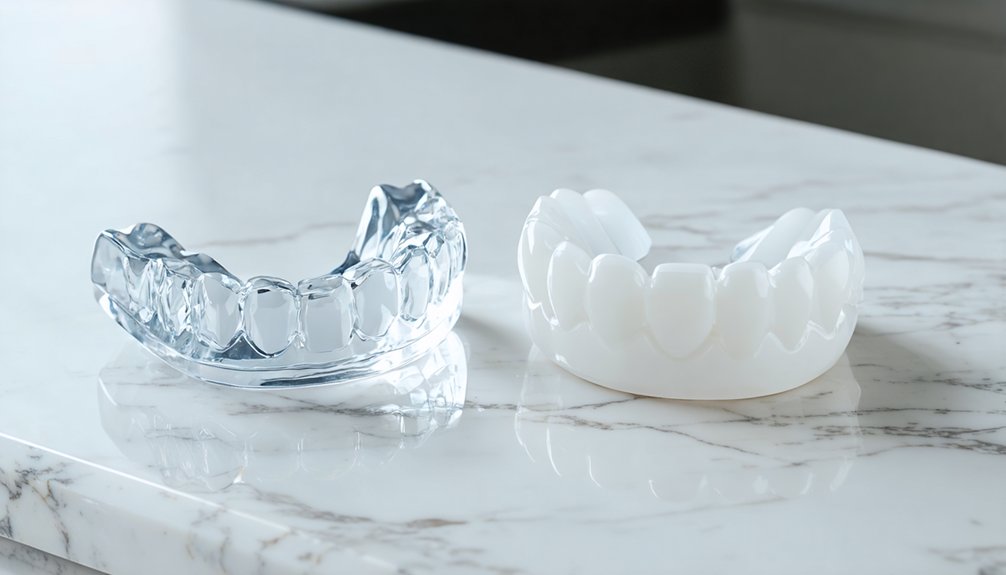
The decision between custom-fit trays and over-the-counter whitening options presents distinct trade-offs in cost, effectiveness, and convenience.
While custom trays require a higher initial investment of $300-600, they offer superior long-term value through reusability and more effective whitening results. OTC products, ranging from $20-100, provide immediate accessibility but may cost more over time due to repeated purchases.
Custom trays deliver enhanced whitening effectiveness through precise fit and higher-concentration gels, ensuring even coverage across tooth surfaces. You’ll experience more controlled sensitivity management due to minimal gum exposure and professional supervision.
Though OTC options offer quick start-up, their lower peroxide concentrations and generic fit typically yield less dramatic results. For those seeking peak results while managing sensitivity, custom trays provide the most reliable and controlled whitening experience despite higher upfront costs.
Natural Methods for Gradual Whitening
While professional whitening treatments offer rapid results, natural whitening methods present cost-effective alternatives for gradual improvement. When choosing natural approaches, it’s crucial to prioritize safety and effectiveness while avoiding potentially damaging techniques.
- Mix baking soda with water sparingly to create a gentle stain-removing paste, being cautious not to overuse and risk enamel wear.
- Practice oil pulling with coconut oil for 15-20 minutes daily to reduce bacteria-causing stains while maintaining oral health.
- Combine lower concentration hydrogen peroxide with baking soda for moderate surface stain removal.
- Avoid acidic fruit applications directly on teeth, as they can permanently damage enamel.
Always monitor for increased sensitivity when using these methods and discontinue use if discomfort occurs. These techniques work gradually but offer gentler alternatives for those with sensitive teeth.
Preventive Measures to Maintain White Teeth
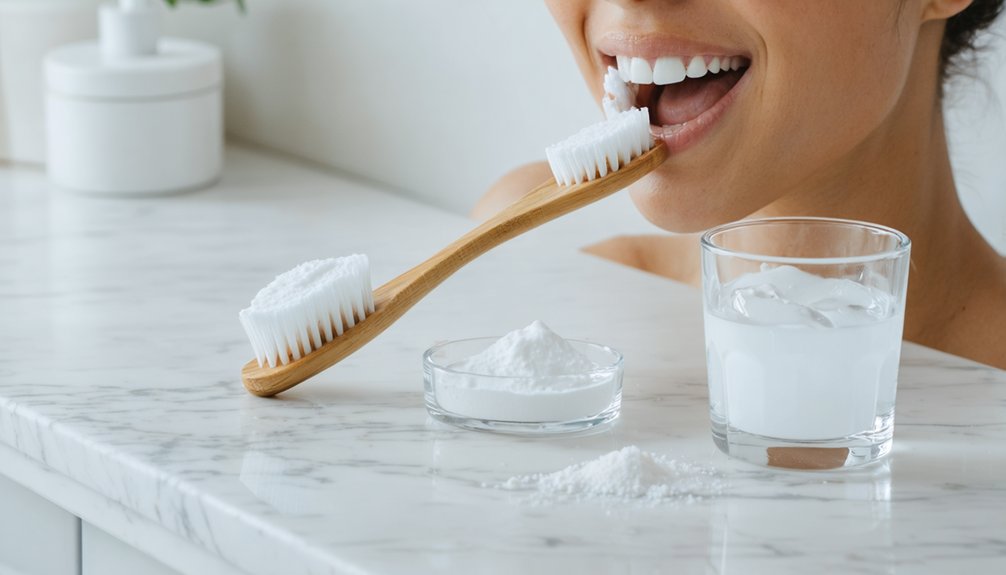
Maintaining pristine tooth whitening results requires a thorough approach to preventive care and sensitivity management.
You’ll need to adopt specific enamel protection strategies to preserve your results while minimizing discomfort. Use a soft-bristled toothbrush and gentle brushing technique to prevent mechanical abrasion, and incorporate desensitizing toothpaste containing potassium nitrate into your daily routine.
Focus on consuming calcium-rich foods to support enamel remineralization, while avoiding acidic and sugary substances that can compromise your teeth’s integrity. Regular dental cleanings are essential for managing plaque buildup and maintaining enamel health.
When consuming potentially staining beverages, rinse your mouth with water afterward. Schedule adequate rest periods between whitening treatments to allow your enamel to recover and maintain peak oral health.
Professional Recommendations for Sensitive Smiles
For patients with sensitive teeth, professional whitening treatments require careful consideration and customized approaches to achieve ideal results without triggering discomfort.
Your dental professional will evaluate your specific sensitivity solutions during thorough dental consultations, ensuring safe and effective treatment outcomes.
- Schedule a dental assessment to identify and address underlying sensitivity causes before initiating any whitening procedures
- Use prescribed fluoride products and sensitivity-specific toothpaste before, during, and after treatments
- Implement a gradual whitening approach with rest periods between sessions to minimize nerve irritation
- Maintain consistent oral hygiene using soft-bristled brushes and avoid temperature extremes during treatment
Latest Innovations in Sensitivity-Friendly Whitening
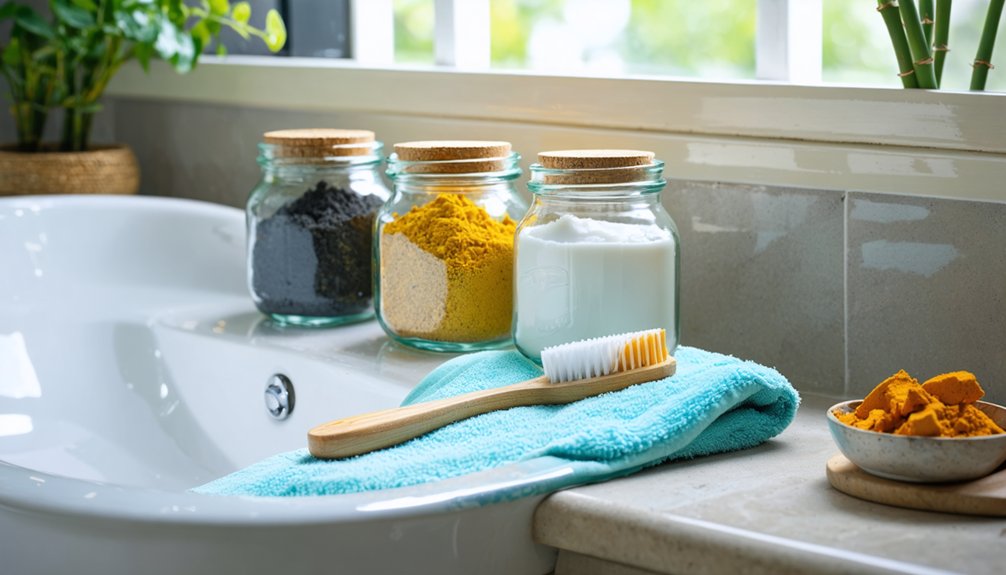
Recent advancements in whitening technology have revolutionized treatment options for patients with sensitive teeth.
You’ll find innovative ingredients like nano-hydroxyapatite and PAP+ that deliver effective whitening without the harsh effects of traditional peroxides. These sensitivity solutions work alongside soothing compounds such as potassium nitrate and fluoride to protect nerve endings while brightening your smile.
LED acceleration systems now enable faster results using lower peroxide concentrations, while customized delivery methods like precision-fit trays minimize gum irritation.
LED technology and precision-fit trays are transforming teeth whitening, delivering faster results with less sensitivity and superior gum protection.
Natural alternatives incorporating botanical elements like aloe vera and coconut oil offer gentle whitening for extremely sensitive cases. Additionally, pH-balanced formulations with essential oils provide antimicrobial benefits while maintaining ideal oral conditions.
These developments guarantee you can achieve a brighter smile without compromising comfort or enamel health.
Frequently Asked Questions
How Long Should I Wait Between Whitening Treatments to Prevent Increased Sensitivity?
For ideal treatment frequency and sensitivity management, you’ll need to wait 6 months between professional treatments, 3-6 months for at-home kits, and 2 months minimum for OTC products.
Can Certain Medications Affect Tooth Sensitivity During Whitening Procedures?
Yes, your medications can considerably impact tooth sensitivity during whitening. Anti-inflammatory drugs like ibuprofen help manage sensitivity, while antihistamines and decongestants may worsen it by reducing protective saliva production.
Are Whitening Results Permanent or Do They Require Periodic Maintenance?
Like morning dew fading with sunrise, your whitening results aren’t permanent. You’ll need maintenance every 6-12 months to preserve whitening longevity, depending on your lifestyle habits and chosen treatment method.
Does Insurance Cover Any Type of Teeth Whitening for Sensitive Teeth?
Your insurance won’t cover teeth whitening for sensitivity, as insurance policies classify it as cosmetic. Even with tooth sensitivity, standard whitening exclusions apply to all methods, regardless of treatment type.
What Age Is Considered Too Young to Start Teeth Whitening Treatments?
Like a delicate flower waiting to bloom, your child’s teeth need time. You shouldn’t start teeth whitening before age 14, when permanent teeth have fully erupted and matured for ideal dental health considerations.
References
- https://www.redrocksfamilydentistry.com/teeth-whitening-options-for-sensitive-teeth/
- https://www.rejuv-health.com/cosmetic-dentistry/teeth-whitening-cost/
- https://buforddentist.com/what-are-the-best-whitening-options-for-sensitive-teeth/
- https://truesmileworks.com/which-teeth-whitening-method-is-best-for-sensitive-teeth/
- https://www.healthline.com/nutrition/whiten-teeth-naturally
- https://www.goodrx.com/conditions/dental-care/is-teeth-whitening-safe
- https://egglestondentalcare.com/best-teeth-whitening-for-sensitive-teeth/
- https://www.clearwavedental.com/comparing-different-teeth-whitening-methods
- http://www.goochlanddentistry.com/whats-the-best-teeth-whitener-for-sensitive-teeth/
- https://pmc.ncbi.nlm.nih.gov/articles/PMC4058574/
